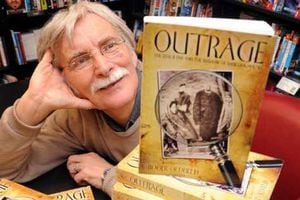Sherlock Holmes author's role in Shropshire scandal
It was a story which caused a sensation in Edwardian England, writes Toby Neal. Ultimately Sir Arthur Conan Doyle, the creator of Sherlock Holmes, was on the case, and top politicians were dragged in.

It was a story which caused a sensation in Edwardian England, writes Toby Neal. Ultimately Sir Arthur Conan Doyle, the creator of Sherlock Holmes, was on the case, and top politicians were dragged in.
In and around a Midlands village there had been a series of outrages in which horses, cows, and sheep had been mutilated and killed in a most brutal and sadistic fashion.
And the young solicitor in the frame for the crimes was George Edalji.
George was the son of the Rev Shapurji Edalji and his wife Charlotte, whose marriage in Ketley, Telford, in 1874 was a rare mixed-culture wedding for its time.
Blighted
Charlotte was the daughter of the Reverend Thompson Stoneham, who had been vicar of St Mary's Church at Ketley since it opened in 1838.
Shapurji was from Bombay, and had been brought up a Parsi, later converting to Christianity.
However, their lives were to be blighted by strange happenings. Somebody seemed to delight in sending them creepy anonymous letters. There were hoaxes and false adverts affecting them.
Then came unwanted fame. In 1903 George was convicted of wounding a pit pony in their home village of Great Wyrley in Staffordshire.
The case gripped the public imagination. George got seven years.
Now a new book - "Outrage: The Edalji Five and the Shadow of Sherlock Holmes" (Vanguard Press, £11.99) - has been published on the whole affair.
Author Roger Oldfield, of Stafford, was once head of history at Great Wyrley High School and was intrigued by the happenings which had thrown that village into the spotlight all those years ago.
"Charlotte and Shapurji were outraged and campaigned passionately to have their son's conviction overturned," he says.
George's aunt, Mary Sancta Stoneham, conducted her own campaign from her home at Much Wenlock. She wrote to the press to declare that the accusation against George was "utterly untrue and false", but she was set back by the death in 1903 of her friend Jasper More, the Ludlow MP.
Suspicion
George was suddenly released in 1906, after three years of his sentence. An inquiry subsequently gave him a free pardon, but no compensation was awarded, as it felt he was himself responsible for a series of menacing anonymous letters sent to all and sundry around the time of the outrages.
If he did write them, a bizarre aspect of the letters was that they openly named him in connection with the crimes, so drawing attention to himself.
The campaign to clear his name from suspicion rumbled on.
"Britain's most famous writer of the time, Sir Arthur Conan Doyle, saw George as the victim of a miscarriage of justice and in 1907 led a passionate campaign to have him declared innocent.
"It seemed that Sherlock Holmes had come to life and newspapers across the world followed Conan Doyle's efforts avidly, most of them mentioning the origins of George's father."
The case dogged the family until attention was distracted by the coming of the First World War.
George disappeared from public view. He loved to come over to Shropshire to walk in the hills, and to see his aunt at Much Wenlock. She later moved to Coalbrookdale, and the widowed Charlotte and daughter Maud went to live with her, close to her Ketley roots.
George died in Welwyn Garden City in 1953, but fascination with the case lives on.
The Edalji name reached prominence again with the publication of the novel "Arthur and George" by top writer Julian Barnes, which almost won the Booker prize in 2005.
"Arthur" is Sir Arthur Conan Doyle and "George" is George Edalji. The novel assumes that Conan Doyle was right to believe that George was innocent.
Naive
Was George, with his heritage, the victim of racial prejudice? Or was "Sherlock Holmes" naive?
Mr Oldfield says Conan Doyle was ignorant of some unfavourable evidence and suppressed the rest. Others have questioned whether George was all he seemed and focussed on those anonymous letters.
Did he write them himself? There was even gossip that he was heavily in debt and that the crimes were part of some weird wager.
In a prominent position in the churchyard at St Mary's, Ketley, is the Stoneham family grave.
Here, with her parents, lies Charlotte Edalji, a Shropshire woman who defied convention and was destined to be caught up in a whirlwind which propelled her into the public eye.





